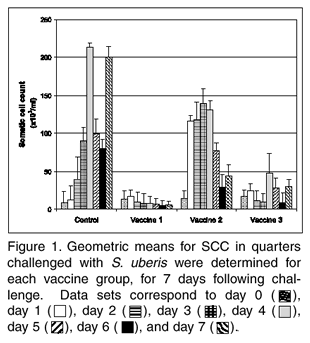Bovine mastitis, an inflammation of the mammary gland, is the single most important factor contributing to economic losses to the dairy industry. Several streptococcal species are capable of causing infections, which result in mastitis. The bacterium S. uberis is a significant problem due to the fact that it is found throughout the dairy environment, and is predominantly associated with sub-clinical mastitis cases, resulting in reduced, and poor quality milk yields.
The development of vaccines against mastitis-causing pathogens has been slow, partly because the infection must be controlled without causing a significant inflammatory response, since this in itself contributes to the disease condition. Currently, treatment practices including antibiotic therapy and teat disinfection are relied upon to minimize the spread of infection. However, these measures are often inadequate, simply because animals are constantly being re-exposed to infection from their surrounding environment. Therefore, there is a clear requirement for an effective vaccine to augment conventional methods of infection prevention.
Three experimental vaccines against S. uberis were developed by VIDo in Saskatoon. Immunization and bacterial challenge of lactating Holstein cows were performed at the UBC Dairy Centre. Four groups of eight animals were selected for vaccination with a placebo or one of the three experimental vaccines. Cows received two subcutaneous injections in the neck at 36 and 15 days prior to challenge with S. uberis. Six cows from each group were chosen based on antibody response to the vaccine antigens. The challenge involved infusion of inoculum containing a culture o f S. uberis into both right quarters of each animal. Milk samples were collected from all quarters, daily for seven days post-challenge, for determination of somatic cell count (SCC) and bacteriology. Daily clinical assessments of animals included measurement of rectal temperatures, presence of clots in the milk, and udder swelling (visual and palpated). A numerical score was assigned to each animal and used as a means of comparing the severity of mastitis among vaccine groups.
Challenged animals displayed signs of disease, and SCC indicated that inflammation had occurred. Between the vaccine groups, no significant differences were observed in rectal temperatures. Clinical scores indicated that there were no significant differences in the severity of infection. Although no differences in milk yield were observed, the quality of milk was slightly affected in all four groups, as discussed below.
Vaccination with vaccine-1 resulted in a significant decrease in SCC, compared to the control group, which did not receive a vaccine (Figure 1). From day three onward, SCC in the cows that received vaccine-1 were significantly lower than in the control cows. SCC in milk from cows that received vaccine-3 were slightly higher than in milk from the vaccine-1 treated animals. However, they were still clearly lower than SCC in milk from the control non-vaccinated group. The SCC in milk from cows that received vaccine-2 increased sharply immediately post-challenge, reaching a maximum at day three, before decreasing erratically over the remainder of the trial. However, the decrease in SCC was not different from that of the control group.
Following challenge with S. uberis, the time period that the quality of milk remained affected was significantly different between vaccine groups. Post-challenge, milk quality in the control, vaccine-1, vaccine-2, and vaccine-3 vaccinated groups was reduced for a total of 21, and 11 days, respectively.

According to the milk quality data, mastitis in the vaccine-2 vaccinated group was similar to that of the control group. Although vaccination with vaccine-1 did not completely prevent reduced milk quality, it did significantly reduce the length of time that milk quality was affected. Vaccination with vaccine-3 also appeared to reduce the length of time that milk quality was affected. Vaccination with vaccine-3 also appeared to reduce the length of time that milk quality was reduced, although not as long as for vaccine-1, which is in keeping with the SCC results.
These experimental results suggest that vaccine-1 is ideally suited for use as a vaccine against S. uberis mastitis. Further research and development for production, licensing and marketing remain to be done by a biologics manufacturer before a vaccine product will be available for use by veterinarians and dairy producers.
For further information about this research on mastitis vaccines, contact Dr. Jim Shelford, Professor in Animal Nutrition at shelford@interchange.ubc.ca
